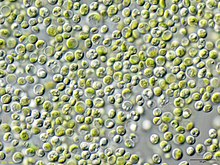| Chlorella | |
|---|---|
 | |
| Chlorella vulgaris | |
| Scientific classification | |
| (unranked): | Viridiplantae |
| Phylum: | Chlorophyta |
| Class: | Trebouxiophyceae |
| Order: | Chlorellales |
| Family: | Chlorellaceae |
| Genus: | Chlorella M.Beijerinck, 1890 |
| Species | |
Chlorella is a genus of about thirteen species of single-celled green algae belonging to the division Chlorophyta. The cells are spherical in shape, about 2 to 10 μm in diameter, and are without flagella. Their chloroplasts contain the green photosynthetic pigments chlorophyll-a and -b. In ideal conditions cells of Chlorella multiply rapidly, requiring only carbon dioxide, water, sunlight, and a small amount of minerals to reproduce.[1]
The name Chlorella is taken from the Greek χλώρος, chlōros/ khlōros, meaning green, and the Latin diminutive suffix ella, meaning small. German biochemist and cell physiologist Otto Heinrich Warburg, awarded with the Nobel Prize in Physiology or Medicine in 1931 for his research on cell respiration, also studied photosynthesis in Chlorella. In 1961, Melvin Calvin of the University of California received the Nobel Prize in Chemistry for his research on the pathways of carbon dioxide assimilation in plants using Chlorella.
Chlorella has been considered as a source of food and energy because its photosynthetic efficiency can reach 8%,[2] which exceeds that of other highly efficient crops such as sugar cane.
https://en.wikipedia.org/wiki/Chlorella
No comments:
Post a Comment